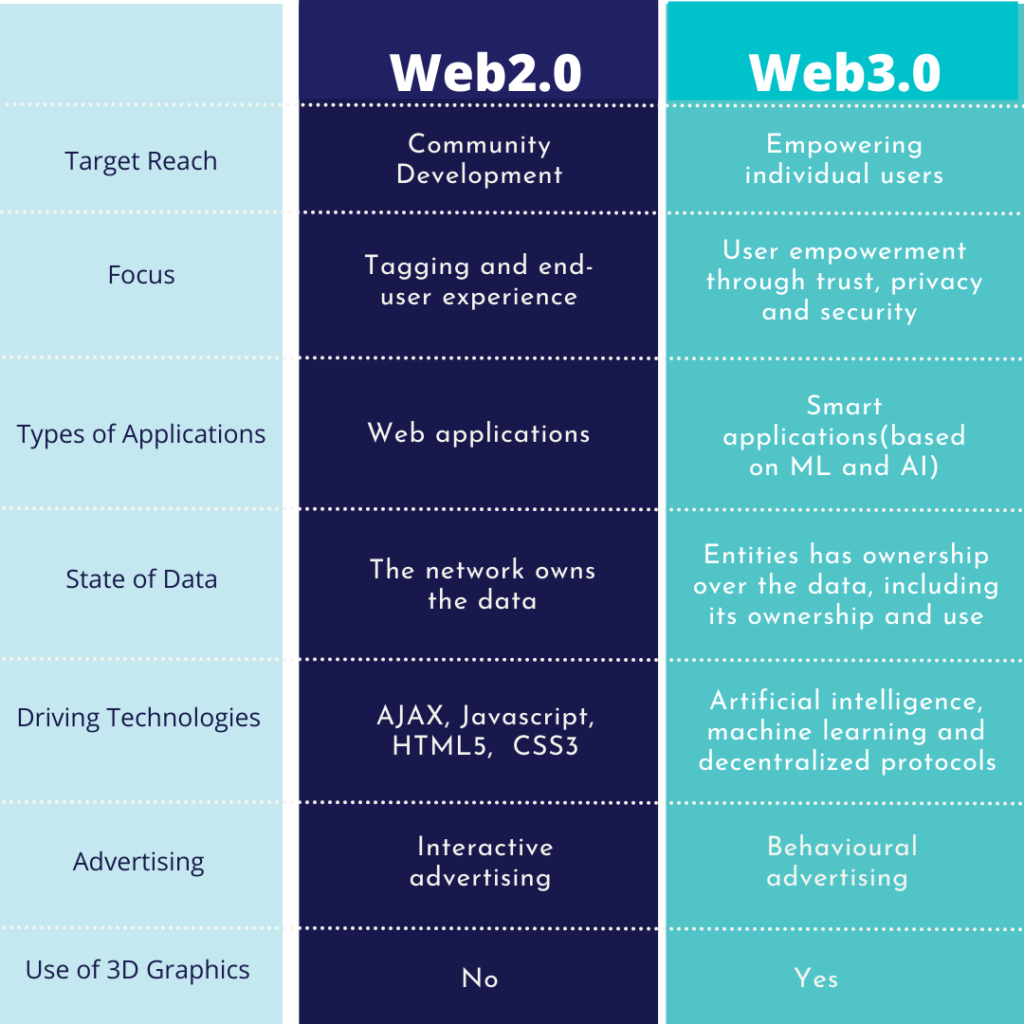
What is Web3: A Beginner’s Guide to the Decentralized Internet
If you are associated with the tech sector, there’s no way you might not have heard of “Web3”. It’s the biggest buzzword right now, along with “Metaverse“.
The web we use and experience today is much more evolved than what it was 10 years ago. This evolution is only going to continue further, with Web3 looking like the next step in this evolution.
In the most basic terms, when people talk about Web 3.0 or Web3, they mean a version of the internet that’s decentralized, free, and most importantly, independent from the clutches of the Big Tech.
Fun fact: In 2021, 57% of all internet traffic was attributable to the Big Tech (Google, Netflix, Facebook, Apple, Amazon, and Microsoft).
But that’s not all. There’s a lot more to Web3.
If you’ve ever wanted to understand what the hype is all about then you are at the right place. In this article, we’ll demystify the concept of Web3. So, let’s begin.
Evolution of the internet
As discussed earlier, the world wide web or the internet has evolved a lot over the years. The applications that are possible today are unrecognizable from almost most of its early days.
This evolution of the web can be categorized into three stages – Web 1.0, Web 2.0, and Web 3.0.

a. Web 1.0
Web 1.0 was the earliest version of the internet, the first iteration. It was static in nature where users could search and consume content using web pages. But that was it. It was a “read-only” web.
The content was served from static file systems instead of a database. There was no interactivity on the websites.
Although it was popular at the time, we soon moved to Web 2.0.
b. Web 2.0
The next iteration, i.e., Web 2.0 came to existence with the dot-com boom and the introduction of today’s tech giants like Facebook, Google, etc.
Web 2.0 was a step up from the previous iteration since it gave users the option to interact with the content posted on websites.
People could post comments, upload photographs or videos, or upload text posts. Web 2.0 is what we experience every day in our lives these days.
Another defining feature of Web 2.0 was that it allowed even non-developers to interact with websites and upload their content. This also allowed people to start earning from their creative efforts.
While all that sounds good, the biggest issue with Web 2.0 came in the form of data security. Data privacy became a major point of conversation.
Although users were initially happy to exchange their data for accessing free services. The issues arose when these big corporations started building giant databases of user data and then selling this data to promote their own business interests. The infamous Facebook data scandal instantly comes to mind.
Not only that, these giant databases were always prone to data hacks and cyberattacks. It was issues like these that paved way for the rise of Web 3.0.
c. Web 3.0
Web 3.0 is the future iteration of the internet that aims to solve the issues that are prevalent with Web 2.0.
This next generation of the internet promotes decentralization powered by blockchain technology and cryptocurrency. Web 3.0 aims to give users ownership and control of their data. It aims to remove the big tech companies as the middlemen so that individuals can provide services to each other and control the aspects of the internet they use.
Key differences between Web3.0 and Web2.0
The table below highlights the difference between Web 2.0 and Web 3.0.

Let’s now discuss the core components of Web3 in the next section.
What are the core components of Web3?
Generally speaking, today’s internet is just an upgraded version of the internet we had in 2010. However, Web3 represents a massive overhaul in terms of how we use and interact with the internet.
From what we’ve discussed so far, we can say that Web3 is the new era of the internet that’s decentralized, meaning the users can get whatever internet service they want without any intrusion of privacy or any control from third-party internet service providers.
Now, let’s discuss the core components of Web3 –
a. Blockchain networks
As discussed before, blockchain technology is the foundation upon which Web3 is built. Using a blockchain network, data is decentralized so users own their data and can trade it without losing its ownership. There is no risk of data breach and there are no intermediaries involved. It also allows users to securely log in to different services.
Moreover, blockchain is also essential for cryptocurrency which is another important element of Web3. Even the non-fungible tokens (NFTs), used to power transactions in Web3, are based on blockchain technology.
b. Artificial intelligence
Although Web 2.0 has its own share of artificial intelligence (AI), it is still primarily controlled by big tech companies. In Web 3.0, we are going to see AI being used to support decentralization.
c. Augmented reality/virtual reality (AR/VR)
AR/VR is another important component of Web3 because this technology will form the foundation of the metaverse which in turn is important for the future of Web3. We’ll talk more about metaverse at the end of the article.

What are the key characteristics of Web3?
Web3 is self-governing, stateful, robust, and has native built-in payments. It is characterized by the following –
a. Decentralized
Since data in Web3 is stored in blockchain, no single system has all the data. It is spread across multiple systems. This promotes decentralized access and encourages multiple failure points.
b. Permissionless
In Web3, users do not need specific permissions to use the internet. Users will be able to access specific services without sharing their personal information. There’s no need to compromise on privacy or share any other data.
c. Secure
Web 3.0 is much more secure than Web 2.0 since decentralization makes it hard for hackers to target specific databases.

Examples of Web3 solutions
While Web3 isn’t fully developed, some of its applications are already becoming quite popular. One such Web3 solution is decentralized finance or DeFi. The DeFi industry is currently worth $200 billion and is expected to grow further.
Some other popular examples of Web3 solutions include the following –
- Bitcoin – Cryptocurrency
- Diaspora – Decentralized social network
- Steemit – Blockchain-based blogging and social platform
- Augur – Decentralized exchange trading market
- OpenSea – NFT marketplace
- Sapien – Decentralized social network
- Uniswap – Decentralized cryptocurrency exchange
- Everledger – Blockchain-based supply chain platform
How does metaverse fit in with Web3?
Metaverse is a social network of 3D virtual worlds where users can interact with each other, play games, or participate in learning activities. Although it’s still in its nascent stage, the metaverse is expected to be an important aspect of Web3.
Although, there will exist many Web3 applications that work without metaverse being involved. But it’s expected that metaverse will play a big role in the way these applications interact with our lives.

What does the future of Web3 look like?
Although it seems like Web3 has the potential to solve most of the problems that Web 2.0 had, it must be noted that these are only ideal visions that have not taken place yet. We cannot assume that things will turn out perfectly as planned.
Moreover, it must be noted that most of the big tech companies are already involved in developing Web3 applications. So it’s hard to imagine their involvement not amounting to some sort of centralization. Many tech entrepreneurs and business leaders have raised the point that Web3 won’t be as decentralized as we expect it to be.
But whatever the case be, it will take some time for Web3 to be fully implemented. We’ll have to wait and see how the future unfolds.
Till then, if you’d like to read more such informative articles then check out Dresma’s blogs.


